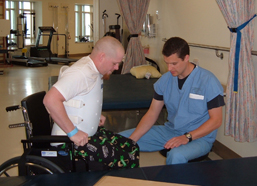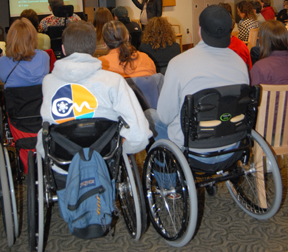The prevalence and implications of sleep apnea in acute, traumatic tetraplegia
Sleep apnea: Why it is a concern in SCI ?
Sleep apnea syndrome is a disorder characterized by frequent, brief pauses in breathing during sleep that reduces oxygen flow to the brain and can cause daytime sleepiness, problems with mental functioning, and depression. While it afflicts about 3% of the general population, it is 10 times more common in the SCI population. Studies of chronically injured individuals estimate that up to 40% of persons with tetraplegia (quadriplegia) have sleep apnea.1, 2 But few sleep apnea studies have focused on the acute, or newly injured, SCI patient.
Dr. Stephen Burns, UW associate professor of rehabilitation medicine, believes it is especially important to understand this problem in acute SCI patients because lack of restful sleep due to apnea can negatively impact a patient’s ability to participate in rehab and learn new mobility and self care skills. It can also interfere with the individual’s adjustment to disability, emotional health and quality of life.
Burns warns that untreated sleep apnea in this population may have other, more devastating consequences as well. “Blood oxygen saturation may drop to 70% or 60% of normal with each pause in breathing. Such episodic oxygen desaturation is not trivial,” because it can impair skin integrity, inhibit wound healing, and may be a factor in the high rate of sudden death seen in SCI patients within the first year after injury.
“We know there are a lot of these so-called non-ischemic cardiac deaths (not due to coronary artery disease) in the SCI population, in which the patient dies suddenly without any other identified cause sometime in the first year after injury,” Burns explains. A rare cause of death in the general population, “It’s actually the second most common cause of death (12.2% of all deaths) after SCI.” It is 10-22 times more common in patients with tetraplegia than in the general population, and three times more common among patients with paraplegia.3
Study objectives and methods
The goal of Burns’ study was to better understand the frequency of sleep apnea in acute SCI and its effect on rehabilitation. Burns recruited patients who had been admitted to Harborview with acute tetraplegia and were undergoing their initial inpatient rehabilitation. Patients were excluded from the study if they had severe traumatic brain injury, a pre-injury diagnosis of sleep apnea, a tracheostomy, or were ventilator-dependent.
Study participants completed a sleep questionnaire and rehabilitation staff rated the patient’s sleepiness. Subjects underwent full polysomnography in their rooms, and if sleep apnea was found, were prescribed treatment by the attending physician.
Findings
During 19 months of enrollment, 58 patients with acute tetraplegia were admitted to Harborview. Two-thirds of these had to be excluded from the study, primarily because they were on a ventilator. Twelve patients were enrolled, nine completed testing, and eight of these were diagnosed with sleep apnea. Staff ratings showed that several patients had at least mild interference with rehab due to excessive sleepiness.
The standard treatment for sleep apnea is CPAP (continuous positive airway pressure), a device that delivers air through a mask strapped onto the face during the night. CPAP was offered to all eight subjects with apnea, but only half tried it, and none of these could tolerate it. “A lot of people on rehab feel, ‘I’m breathing on my own, I’m off the vent, there’s so much else going on, I don’t want to have to deal with (CPAP),’” Burns explains. Those who try it often report a feeling of claustrophobia, especially if they have limited hand function and cannot easily adjust the face mask. According to Burns, a treatment called BiPAP, which delivers alternating higher and lower positive pressures timed with the breathing cycle, may be a better choice for this population because it tends to make the higher pressures more tolerable.
Based on a review of records after discharge, half the patients who had been excluded from the study were considered to be at high risk for sleep apnea because of high injury levels and severe weakness of respiratory muscles. “Although (patients like these) will eventually develop sleep apnea, it will not occur during initial rehabilitation, so there is less opportunity to diagnose it,” Burns warns. “They need to be followed and tested soon after discharge.”
An Australian study published in June 2005 found high rates (60%-70%) of sleep apnea during the first year after injury.4 Based on this and his own previous study,1 Burns believes the high rate of sleep apnea in this population may warrant testing everyone for it, even if no other symptoms are present.
The best way to diagnose sleep apnea in this study would be full bedside polysomnography, but this requires special equipment and staff training that are unavailable on most inpatient units today. A simpler alternative may be sufficient, says Burns: “Because sleep apnea and the resulting blood oxygen desaturation are so severe in this population, just measuring blood oxygen levels overnight (using a pulse oximeter designed specifically for sleep studies) may be enough to diagnose it.”
Although it had a small number of subjects, Burns’ study is the first to examine the effects of sleep apnea on initial SCI rehabilitation participation. Burns recommends that future studies investigate the effectiveness and acceptability of other treatments, such as BiPAP and dental appliances, and should include a larger number of subjects from multiple centers. Meanwhile, at the Puget Sound VA in Seattle, Burns and his colleagues will soon start testing most newly injured SCI patients for sleep apnea and training them to use BiPAP early during the rehabilitation process.
References
1. Burns SP, Little JW, Hussey JD, et al. Sleep apnea syndrome in chronic spinal cord injury: associated factors and treatment. Arch Phys Med Rehabil 2000;81:1334-1339.
2. Stockhammer E, Tobon A, Michel F, et al. Characteristics of sleep apnea syndrome in tetraplegic patients. Spinal Cord. 2002 Jun;40(6):286-94.
3. DeVivo MJ, Stover SL. Long-term survival and causes of death. In: Stover SL, Whiteneck GG, eds. Spinal Cord Injury. Clinical Outcomes from the Model Systems. Gaithersburg, MD: Aspen Publishers, Inc., 1995:289-316.
4. Berlowitz DJ, et al. A Longitudinal Evaluation of Sleep and Breathing in the First Year After Cervical Spinal Cord Injury. Arch Phys Med Rehabil. 2005 Jun; 86(6):1193-99.






